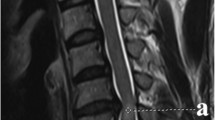Summary
Outcome from surgery for cervical spondylosis is often disappointing. To identify possible causes of poor outcome 56 such patients referred for post-operative computed myelography or MRI were evaluated, 22 of which eventually had further surgery. Alternative diagnoses to cervical spondylosis were eventually established in 14.3 %; 26.8% had spinal cord atrophy 15.6% of which also had myelomalacia; 28.6% had diffuse spinal canal stenosis; and in 57.1% surgery had failed to decompress the spinal canal. These findings can be partly explained by patient selection criteria; nevertheless they do serve to emphasises the point often ignored in discussions of the efficacy of surgery in cervical spondylosis, that operations significantly often fail to achieve adequate decompression. Furthermore there was no evidence in this material that osteophytes regress after spinal fusion.
Similar content being viewed by others
References
Mair WPG, Druckman R (1953) The pathology of spinal cord lesions and their relation to the clinical features in protrusion of cervical intervertebral discs (a report of four cases). Brain 76: 70–79
Adams CBT, Logue V (1971) Studies in cervical spondylotic myelopathy II. The movement and contour of the spine in relation to the neural complications of cervical spondylosis. Brain 94: 569–586
Schmidek HH, Smith AS (1988) Anterior cervical disc excision in cervical spondylosis. In: Operative neurosurgical techniques. Grune and Stratton, New York, pp 1327–1324
Nurick S (1972) The pathogenesis of the spinal cord disorder associated with cervical spondylosis. Brain 95: 87–100
Campbell AMG, Phillips DG (1960) Cervical disc lesions with neurological disorders. Differential diagnosis, treatment and prognosis. Br Med J 2: 481–485
Clarke, Robinson PK (1956) Cervical myelopathy; complication of cervical spondylosis. Brain 79: 483
Lees F, Turner JWA (1963) Natural history and prognosis of cervical spondylosis. Br Med J 2: 1607
Ono K, Ota H, Tada K, Yamamoto T (1977) Cervical myelopathy secondary to multiple spondylotic protrusions: a clinicopathologic study. Spine 2: 109–125
Hughes JT (1984) Disorders of the spine and spinal cord. In: Greenfield's neuropathology. Arnold, London, pp 799–806
Scotti G, Scialfa G, Pieralli S (1983) Myelography and radiculopathy due to cervical spondylosis: myelographic-CT correlations. AJNR 4: 601–603
Yu YL, du Boulay GH, Stevens JM, Kendall BE (1986) Computed tomography in cervical spondylotic myelopathy and radiculopathy: visualisation of structures, myelographic comparison, cord measurements and clinical utility. Neuroradiology 28: 221–236
Lee SH, Coleman PE, Hahn FJ (1988) Magnetic resonance imaging of degenerative disk disease of the spine. Radiol Clin North Am 26: 949–964
Fujiwara F, Yonenobu K, Ebara S, Yamashita K, Ono K (1989) The prognosis of surgery for cervical compression myelopathy. (An analysis of the factors involved). J Bone Joint Surg [Br] 71B: 393–398
Miller DH, McDonald WI, Blumhardt LD, DuBoulay GH, Halliday AM, Johnson G, Kendall BE, Kingsley DP, MacManus DG, Moseley IF (1987) Magnetic resonance imaging in isolated non compressive spinal cord syndromes. Ann Neurol 22: 714–723
Stevens JM, O'Driscoll DM, Yu YL, Kendall BE, Anathapavan S (1987) Some dynamic factors in compressive deformity of the cervical spinal cord. Neuroradiology 29: 136–142
Collias JC, Roberts MP (1988) Posterior operations for cervical disc herniation and spondylotic myelopathy. In: Operative neurosurgical techniques. Grune and Stratton, New York, pp 1347–1357
Cloward RB (1958) The anterior approach for removal of ruptured cervical discs. J Neurosurg 15: 602–607
Smith GW, Robinson RA (1958) The treatment of certain cervical spine disorders by anterior removal of intervertebral disc and interbody fusion. J Bone Joint Surg [Am] 40: A607-A624
Aronsen N, Filtzler Dl, Bagan M (1958) Anterior cervical fusion by Smith-Robinson approach. J Neurosurg 29: 369–404
Lunsford LD, Bisonette D, Jannetta PJ, Sheptak PE, Zorub DS (1980) Anterior surgery for cervical disc disease. Part 1: treatment of lateral disc herniation in 32 cases. J Neurosurg 53: 1–11
Lunsford LD, Bisonette D, Zorub DS (1980) Anterior surgery for cervical disc disease. Part 2: treatment of cervical spondylotic myelopathy in 32 cases. J Neurosurg 53: 12–19
Hukuda S, Mochizuki T, Ogata M, Shichikawa K, Shimomura Y (1985) Operations for cervical spondylotic myelopathy (A comparison of the results of anterior and posterior procedures). J Bone Joint Surg [Br] 67B: 609–615
Walker J, Gillespie R, Davis J, Dawson (1988) Water-soluble contrast medium for intraoperative evaluation of anterior cervical discectomy. J Neurosurg 68: 491–492
Author information
Authors and Affiliations
Rights and permissions
About this article
Cite this article
Clifton, A.G., Stevens, J.M., Whitear, P. et al. Identifiable causes for poor outcome in surgery for cervical spondylosis. Neuroradiology 32, 450–455 (1990). https://doi.org/10.1007/BF02426453
Received:
Issue Date:
DOI: https://doi.org/10.1007/BF02426453




